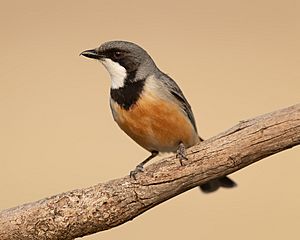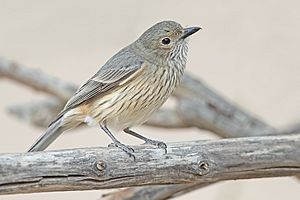Rufous whistler facts for kids
Quick facts for kids Rufous whistler |
|
|---|---|
 |
|
| Male | |
 |
|
| Female | |
| Conservation status | |
| Scientific classification | |
| Genus: |
Pachycephala
|
| Species: |
rufiventris
|
| Subspecies | |
|
See text |
|
| Synonyms | |
|
|
The rufous whistler (Pachycephala rufiventris) is a type of bird called a whistler. You can find it in New Caledonia and Australia. This bird is mostly reddish-brown and grey. Even though its feathers are not super bright, it sings beautiful songs! Like other whistlers, it has many different musical calls.
Contents
About the Rufous Whistler's Name
The rufous whistler got its first scientific name from an English bird expert named John Latham in 1801. He first put it in a group called Sylvia. Over time, scientists moved it to different bird groups. Now, it is in its current group, Pachycephala.
Other names for this bird include the rufous-bellied whistler and white-bellied whistler. Be careful, though! There is another bird called the white-bellied whistler (Pachycephala leucogastra) which is a different species.
Different Types of Rufous Whistlers
Scientists recognize five different types, or subspecies, of the rufous whistler:
- P. r. minor – Zietz, FR, 1914: This type lives on Melville and Bathurst Islands, which are off northern Australia.
- P. r. falcata – Gould, 1843: This type was first thought to be its own species. It lives in northern Australia.
- P. r. pallida – Ramsay, EP, 1878: This type was also first thought to be its own species. You can find it in north-eastern Australia.
- P. r. rufiventris – (Latham, 1801): This is the most common type. It lives in most parts of Australia, except the very north.
- P. r. xanthetraea – (Forster, JR, 1844): This type was first described as a different kind of bird. It lives in New Caledonia.
What Does a Rufous Whistler Look Like?
Rufous whistlers have large heads and strong, stocky bodies. They have short beaks. Their tails are long, almost as long as the rest of their body. These tails are narrow and have sharp, forked tips.
Male and Female Differences
Male and female rufous whistlers look different. This is called sexual dimorphism.
- Females are usually dull brown or grey. Their undersides have streaks.
- Males are mostly dark-grey. They have white throats. Most males also have a black mask that covers much of their head and part of their neck.
These birds are usually between 16 and 18 centimetres (6.3–7.1 inches) long. They weigh about 25 grams (0.9 ounces).
Their Amazing Songs
The rufous whistler is known for its many musical calls. These calls are a long series of ringing notes. It sounds like they are singing a beautiful tune!
Where Rufous Whistlers Live
You can find rufous whistlers in many places. They live in forests, woodlands, and areas with shrubs. They also visit gardens and farmlands.
These birds travel with the seasons. They move south in the spring and north in the autumn. In New Caledonia, they do not migrate. They stay in the same areas of open forest and savannah all year.
Behaviour and Life Cycle
Reproduction and Nests
Rufous whistlers form pairs and stay together for breeding. Both the male and female help. They both sit on the eggs to keep them warm. They also both take care of their young birds. Eggs usually hatch after about 13 days.
The female bird builds the nest all by herself. She uses twigs, vines, grass, and other materials. She shapes the nest like a cup. She attaches it to a tree branch using strands from spider webs.
The breeding season for rufous whistlers is from July to February.
What Rufous Whistlers Eat
Rufous whistlers mainly eat insects. But they also enjoy seeds, fruit, and sometimes even leaves and grasses. It is interesting that they never look for food on the ground. This is a bit unusual because many other whistlers do not usually look for food very high up.
See also
 In Spanish: Silbador rufo para niños
In Spanish: Silbador rufo para niños


